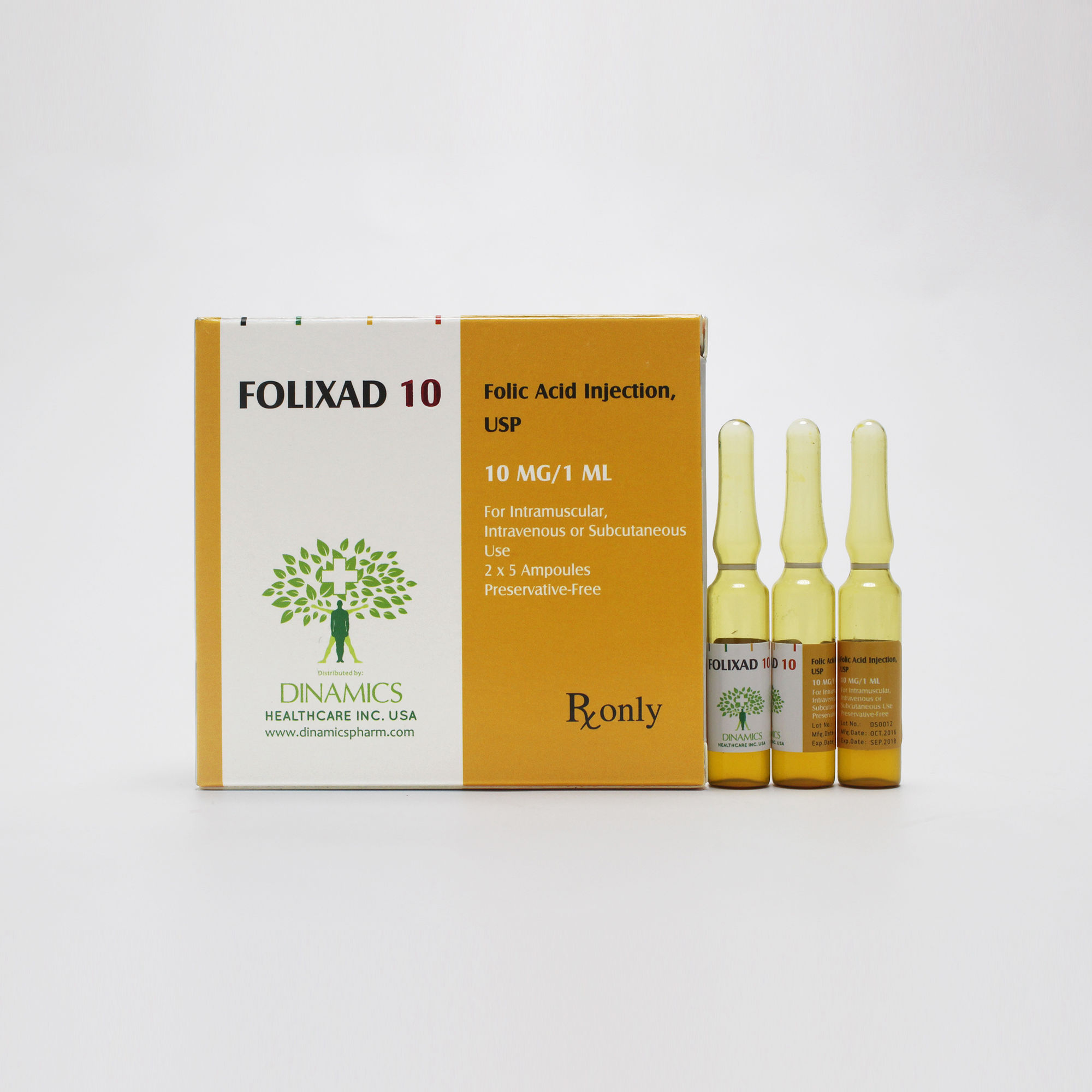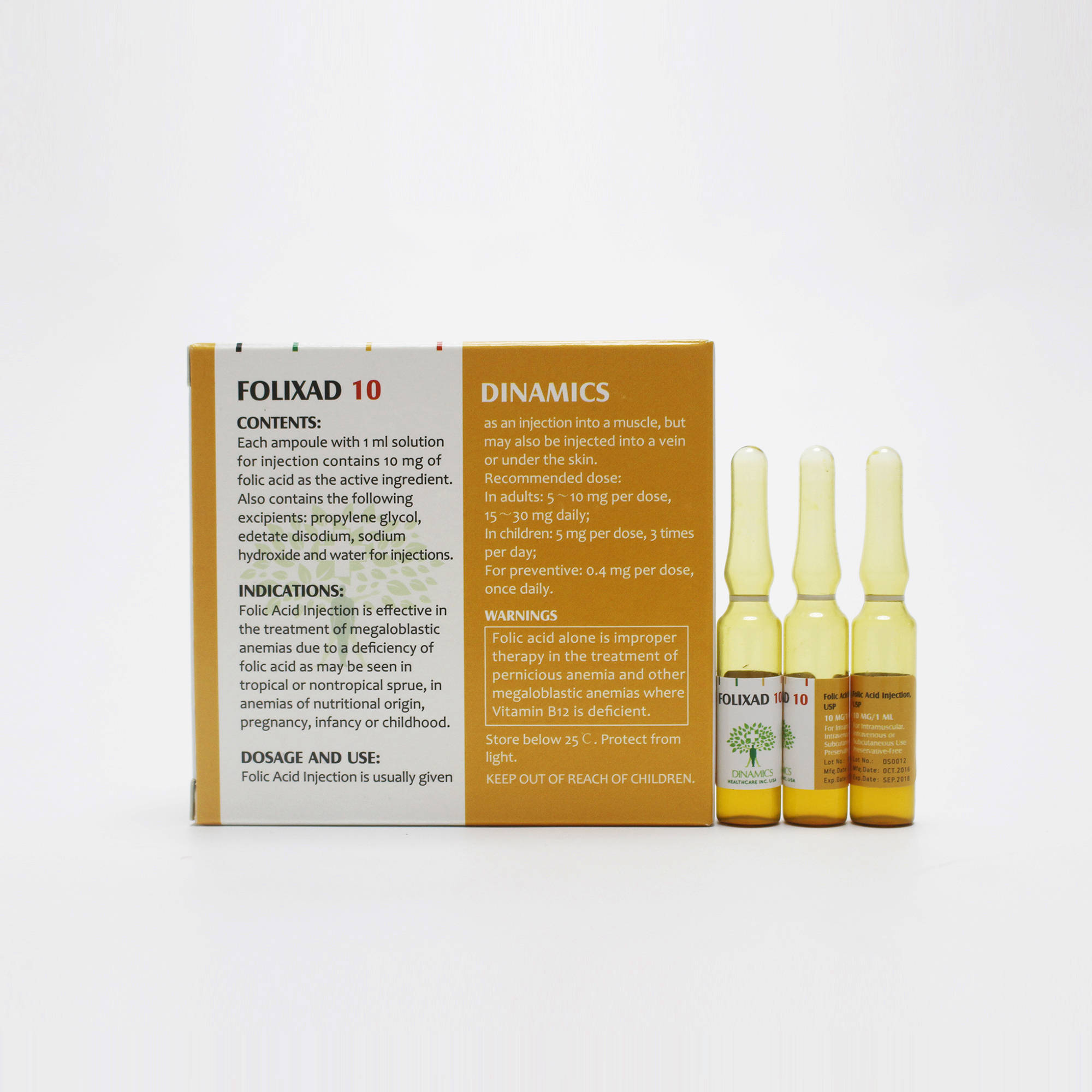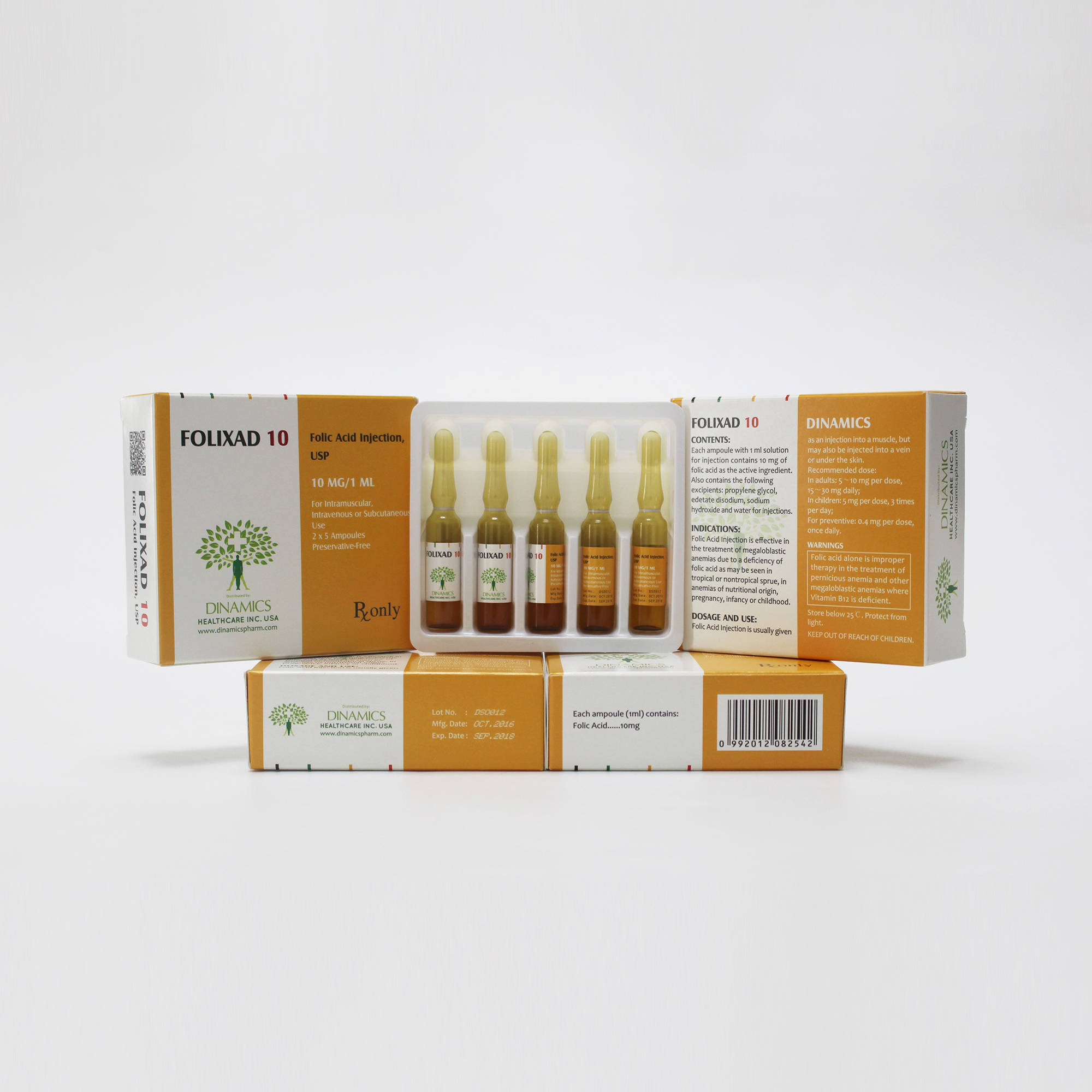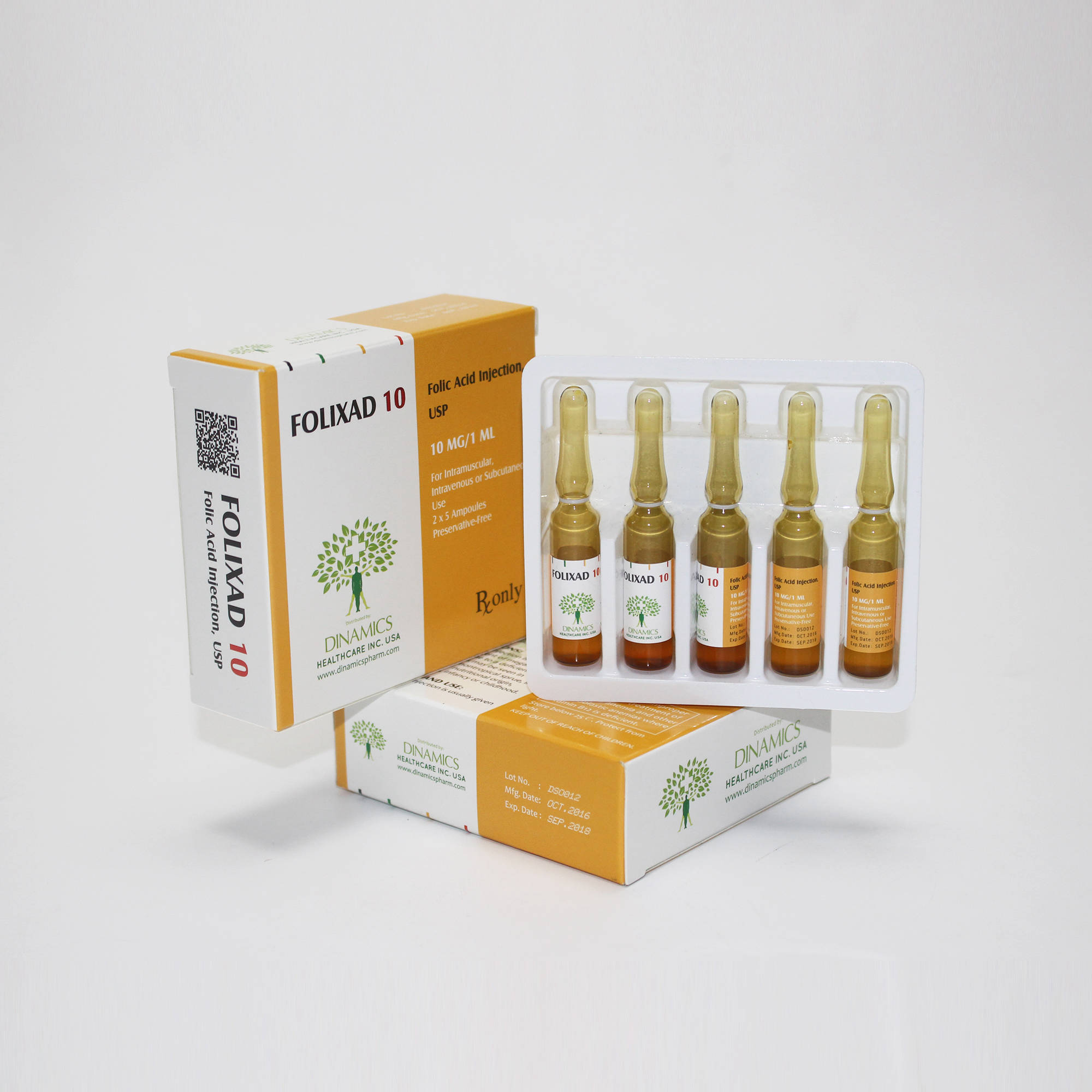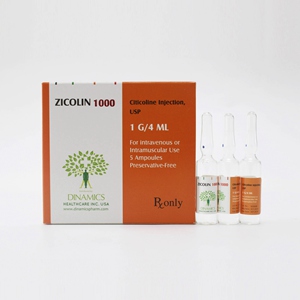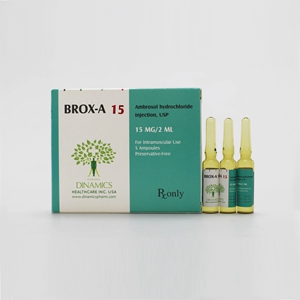Folid Acid Injection
QUICK DETAILS:
FOLIXAD 10 Contents:
•Each active substance is folic acid. Each ml contains 10 mg of folic acid.
•The other ingredients are: propylene glycol, edetate disodium, sodium hydroxide and water for injections.
FOLIXAD 10 Character:
•FOLIXAD 10 is a clear, light yellow solution, free from visible particles. It is supplied in a brown 2mL glass ampoule.
FOLIXAD 10 Pack:
5 ampoules per tray, 2 trays per carton.
DESCRIPTION
1. What FOLIXAD 10 is and what it is used for
Folic Acid Injection, is a sterile, nonpyrogenic solution of sodium folate (prepared by the addition of sodium hydroxide to folic acid) in Water for Injection intended for intramuscular (IM), intravenous (IV) or subcutaneous (SC) use. Folic acid belongs to a group of medicines called vitamins.
Folic Acid Injection is effective in the treatment of megaloblastic anemias due to a deficiency of folic acid as may be seen in tropical or nontropical sprue, in anemias of nutritional origin, pregnancy, infancy or childhood.
2. What you need to know before you take FOLIXAD 10
When you must not be given it
You should not be given FOLIXAD 10 if you have an allergy to:
•any medicin containing folic acid
•any of the ingredients listed at the end of the leaflet
•any other similar medicines
Some of the symptoms of an allergic reaction may include:
•shortness of breath
•wheezing or difficulty breathing
•swelling of the face, lips, tongue or other parts of the body
•rash itching or hives on the skin.
You should not be given this medicine if your anaemia is caused by a vitamin B12 deficiency.
You should not be given Folic acid Injection if the solution is discoloured, cloudy, turbid, or a precipitate is present. The solution is normally a clear, light yellow solution.
The doctor or nurse will check to ensure the medicine is not past its expiry date and has not been tampered with.
If you are not sure whether you should be given this medicine, talk to your doctor.
Before you are given it
Tell your doctor if you have allergies to any other medicines, foods, preservatives or dyes.
Tell your doctor if you have or have had any of the following medical conditions:
•a cancer, which causes tumours.
•megaloblastic anaemia due to vitamin B12 deficiency.
•hypersensitivity to folic acid.
Tell your doctor if you have any other medical conditions.
Tell your doctor if you are pregnant or plan to become pregnant or are breast-feeding.
Your doctor can discuss the risks and benefits involved.
If you have not told your doctor about any of the above, tell him/her before you are given Folic Acid Injection.
Taking other medicines
Tell your doctor if you are taking any other medicines, including medicines that you buy without a prescription from your pharmacy, supermarket, health food shop, naturopath or herbalist.
Some medicines and Folic Acid Injection may interfere with each other. These include:
•medicines used to treat epilepsy, such as anticonvulsant drugs.
•multivitamin preparations
•large amounts of alcohol
•medicines used to treat cancer, such as methotrexate
•medicines used to treat infections, such as trimethoprim
•medicines used to prevent malaria, such as pyrimethamine
•medicines used to treat bowel disease, such as sulfasalazine.
•medicines used to treat high blood pressure.
These medicines may be affected by Folic Acid Injection, or may affect how well it works. You may need different amounts of your medicines, or you may need to take different medicines.
Your doctor has more information on medicines to be careful with or avoid while being given Folic Acid Injection.
Things to be careful of
Be careful driving or operating machinery until you know how Folic Acid
Injection affects you.
Be careful when drinking alcohol while you are being given this medicine.
This medicine may not work as well if you drink alcohol.
If you feel light-headed, dizzy or faint when getting out of bed or standing up, get up slowly.
DIRECTION
1.How to take FOLIXAD 10
How it is given
Folic Acid Injection is usually given as an injection into a muscle (intramuscular, IM), but may also be injected into a vein (intravenous, IV) or under the skin (subcutaneous, SC).
How much is given
Your doctor will decide what dose of Folic Acid Injection you will receive and for how long you will receive it. This depends on your medical condition and other factors, such as your weight or age. Sometimes only a single dose is required. The reference dosage is as following:
In adults: 5~10 mg per dose, 15~30 mg daily;
In children: 5 mg per dose, 3 times per day;
For preventive: 0.4 mg per dose, once daily.
If you are given too much (overdose)
As Folic Acid Injection is always given to you in a hospital under the supervision of a doctor, it is unlikely that you will receive an overdose.
Symptoms of an overdose are the same as the side effects but may be more severe. The symptoms of a side effect are listed under Side effects below.
If you notice any symptoms of an overdose immediately contact your doctor or go to the Emergency department at the nearest hospital.
2..Possible side effects
Tell your doctor or nurse as soon as possible if you do not feel well while you are being given Folic Acid Injection.
This medicine helps most people with megaloblastic anaemia caused by folic acid deficiency, but it may have unwanted side effects in a few people. All medicines can have side effects. Sometimes they are serious, but most of the time they are not. You may need medical treatment if you get some of the side effects.
Do not be alarmed by the following list of side effects, you may not experience any of them.
Ask your doctor to answer any questions you may have.
Tell your doctor or nurse if you notice any of the following and they worry you:
•nausea
•diarrhoea or wind
•rash
•irritability
•sleep disturbances.
The above list includes the more common side effects of your medicine. They are usually mild and short-lived.
If any of the following happen, tell your doctor or nurse immediately or go to the Emergency Department at your nearest hospital:
•difficulty breathing, wheezing or coughing
•change in heart rate or chest pain
•fits or seizures
•allergic reaction.
The above list includes some very serious side effects. You may need urgent medical attention or hospitalisation. These side effects are very rare.
Tell your doctor or nurse if you notice anything that is making you feel unwell.
Other side effects not listed above may occur in some people.
INGREDIENTS
Contents of the pack and other information
What FOLIXAD 10 contains
•Each active substance is folic acid. Each ml contains 10 mg of folic acid.
•The other ingredients are: propylene glycol, edetate disodium, sodium hydroxide and water for injections.
What FOLIXAD 10 looks like and contents of the pack
•FOLIXAD 10 is a clear, light yellow solution, free from visible particles. It is supplied in a brown 2mL glass ampoule.
•Pack size:
5 ampoules per tray, 2 trays per carton.
STORE
How to store FOLIXAD 10
Keep this medicine out of the sight and reach of children.
Store at temperature not exceeding 25°C. Do not refrigerate or freeze.
Keep the ampoules in the outer carton until time of use in order to protect from light.
Do not use this medicine after the expiry date ‘EXP’ shown on the container. The expiry date refers to the last day of that month.
Do not throw away any medicines via wastewater or household. Ask your pharmacist how to throw away medicines you no longer use. These measures will help protect the environment.


